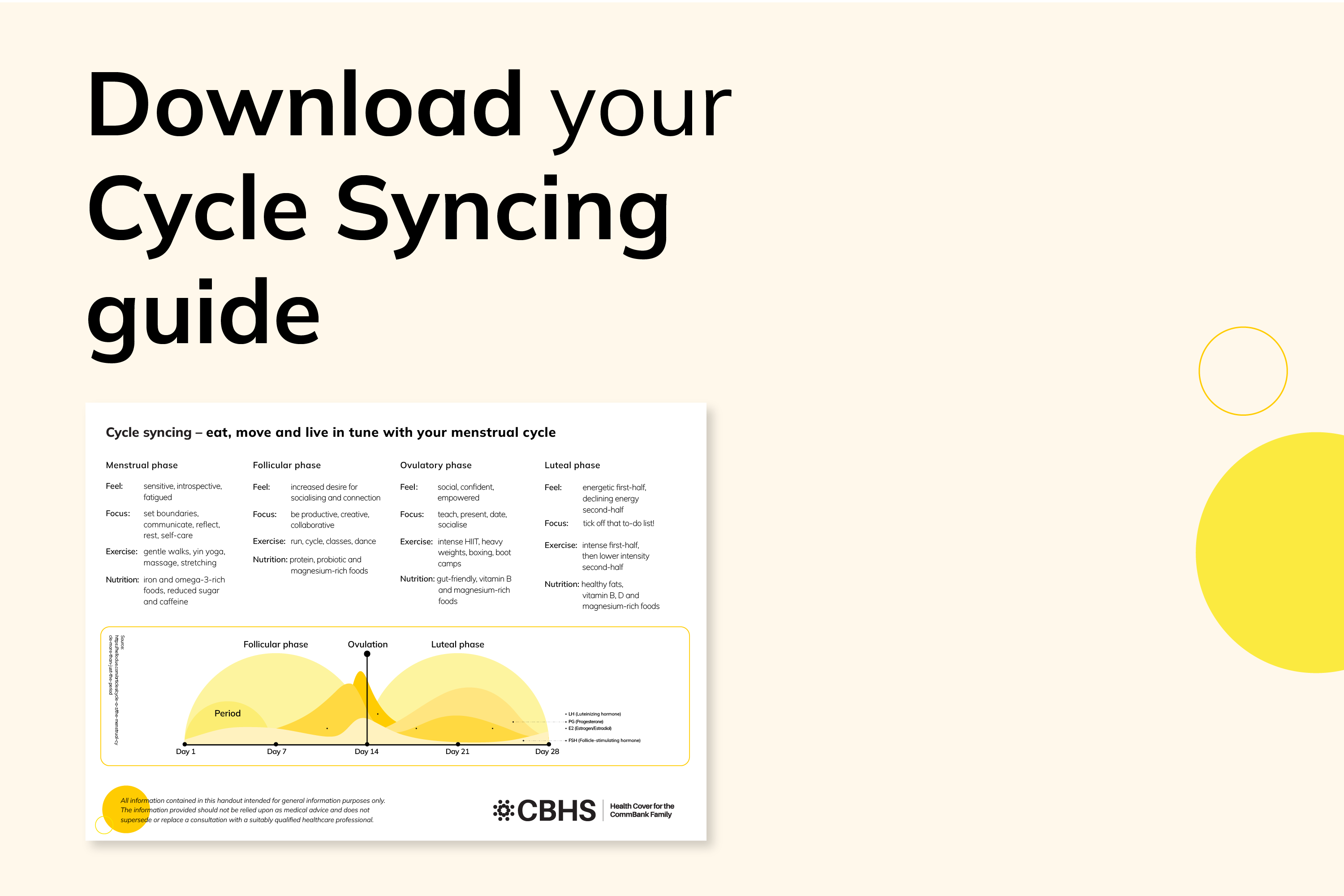- Home
- Mind & body
- Understanding your menstrual cycle: the power of cycle syncing
At CBHS we help you manage your health challenges. We believe in offering you the services, support and tools you need to live your best life.
Our Better Living Programs are available to support eligible members towards a healthier lifestyle. Each Better Living Program is subject to its own eligibility criteria.
Contact us for more information and to confirm your eligibility for a program.
Understanding your menstrual cycle: the power of cycle syncing

Your menstrual cycle is more than a monthly event; it's a complex hormone party. It can influence your energy, mood, and even your cravings. However, nowadays it’s possible to adapt this to your advantage. Cycle syncing is a trending practice that has moved beyond professional sports and into the mainstream. In fact, the U.S. women’s soccer team helped to popularise cycle syncing, having followed the practice in the lead-up to their 2019 World Cup win.
Cycle syncing involves adjusting your routine to align with the phases of your menstrual cycle. The aim is to optimise your wellbeing and make the most out of each phase. Let's delve into the details of cycle syncing and how it can benefit you.
The menstrual cycle is simply the body preparing for pregnancy. If you’re not pregnant, your hormones send a signal to your uterus to shed its lining, which becomes your period. The cycle starts from day one of your period, and it is made up of four phases.
The average length of a menstrual cycle is 21-38 days, but every woman’s cycle is different.
Exercise, diet, and your period
The number of different hormones (like progesterone and oestrogen) in your body varies throughout your cycle. It’s important to keep an eye on your diet and exercise, as they will directly impact our cycle symptoms.
Studies have shown that women who exercise regularly are less likely to suffer menstrual pain, cramps, or mood disturbances. It is thought that this could be due to exercise boosting ‘happy’ hormones such as serotonin and endorphins.
Looking after your diet means eating the recommended amount of fruits and vegetable while avoiding excess salt, caffeine and saturated fats. Eating well can extend to ensuring you’re consuming a diet rich in omega-3 fatty acids, vitamins B6, B1, E and D, as well as magnesium, calcium and zinc. These nutrients may help you manage your symptoms a bit better.

So, what is cycle syncing?
Cycle syncing involves matching your activity calendar to the body’s symptoms during hormonal changes. Each of the four menstrual cycle phases affects us differently. Impacts can include changes in muscle strength, recovery, energy, emotional state, and even creativity or desire for social engagement. By syncing your daily routines with these hormonal shifts, you can potentially use your energy levels to your advantage, promoting overall harmony and deeper connection with your body.
“The idea that you can and should listen to your body is revolutionary,” says psychologist Susan Albers, PsyD.
Dr. Albers notes that the cycle syncing lifestyle hasn’t been researched in a clinical setting. It’s also acknowledged that much of the research in the space relates to professional athletes, and that there is a need for more research within the general population. But with that said, there’s a lot of research supporting differences in mood and activity levels during each phase of the menstrual cycle.
People often focus on syncing diet and exercise to their cycle. But you can extend the practice to other aspects of your life, such as work and relationships.

The phases of your menstrual cycle
Menstrual phase (Days 1-7): Your energy levels are relatively lower during this phase. Oestrogen and progesterone levels are at their minimum. It’s the time to focus on light exercise and self-care.
Our CBHS Health Hub dietitian, Meg Hasick, advises that during the menstrual phase, our internal body temperature is cooler, so it’s good to focus on warming, grounding, and satiating foods like nutrient-rich soups and stews, and easy-to-digest cooked vegetables.
“Iron deficiency is one of the most common nutritional deficiencies among women of child-bearing age, contributing to low energy and fatigue. We lose iron when we bleed, so it’s even more important to focus on iron-rich foods during our menstrual phase, including red meat, poultry, fish, oysters, tofu, and dark leafy greens. Pair these foods with foods high in vitamin C, including berries, citrus fruits, and capsicum to boost your immunity.
Another important nutrient to focus on during your menstrual phase is omega-3 fats for their soothing, anti-inflammatory properties, which can help relieve cramps. Foods rich in omega-3 include oily fish such as salmon, tuna, mackerel, and sardines, as well as eggs, flaxseeds, and walnuts.
It’s important to reduce caffeine during this phase as coffee, green tea, and black tea have polyphenols that reduce iron absorption. Caffeine can also tighten/narrow our blood vessels, which can make cramps worse. Stick to decaf and herbal teas, if not, make sure to separate your iron and caffeine consumption.
You should also try to go easy on sugar during this time to keep blood sugar balanced and avoid further inflammation.”
On the exercise front, Meg says to use the opportunity to rest and put yourself first – run a hot bath, sleep for longer, journal, or take a nice walk outdoors. How you take care of yourself during this phase sets the tone for the rest of your cycle. The more you rest during menstruation, the more energy and vitality you’ll have during the other phases of your cycle. Tune into how you feel and honour that! If you do feel like exercising, you could focus on more restorative forms such as gentle walks, yin yoga, stretching and foam rolling.

Follicular phase (Days 8-14): With oestrogen gradually increasing, you might feel like you have more energy. You may even feel more confident, with an increased desire for socialising and connection, you may feel a bit lighter in your body, and be excited for new possibilities.
Meg suggests nutrient-rich foods such as probiotics like sauerkraut, kimchi, yoghurt, kefir, and fermented vegetables which support the gut microbiome and hormone regulation. Foods rich in phytoestrogens will also aid healthy oestrogen production, such as flax seeds, organic tofu, avocado and wholegrain oats.
Protein-rich animal foods such as eggs and fish should be paired with green leafy vegetables high in vitamin E to support detoxification and follicle growth. Pumpkin, red capsicum, beet greens and spinach are all easy options to add to your plate.
“Most of the population is deficient in magnesium, which supports all hormonal processes in the body, promotes thyroid health, helps regulate blood sugar, nourishes your nervous system and helps metabolise oestrogen. So, we need to refill our magnesium stores every day. This is even more important for those with any hormonal conditions/symptoms such as PCOS, endometriosis, adenomyosis, stress, anxiety, migraines or poor sleep. Magnesium-rich foods include nuts and seeds, dark leafy greens, avocado, legumes, kefir and dark chocolate,” says Meg.
During the follicular phase, our metabolism slows slightly whilst energy levels increase, so we’re naturally not as hungry and can dial up the exercise a notch! The body likes to burn fat for fuel here, so think endurance and high-intensity exercise like running, cycling, hot yoga, and dancing.

Ovulation phase (Days 15-17): Oestrogen peaks, and you might feel a heightened energy level and better mood. On the social front, you may want to plan an evening out with friends during this more energetic phase of your cycle, as you could be more tempted to stay home and binge-watch TV right before or during your period. Use this time to plan adventures with friends, explore new places, and try fresh activities together!
Meg’s advice for the third phase is this: As our energy is high, use this time to get into the kitchen and cook up a storm! Meal prep for the week and freeze your meals or try out some new recipes.
“Since our liver and gut are responsible for the detoxification of oestrogen, it’s important to give them extra support. Anti-inflammatory, nutrient-dense, fibre-rich whole foods, including fresh vegetables, fruits, nuts, and seeds are recommended to help flush out excess oestrogen and keep things moving. These foods will also cool your body down as our peaked hormone levels result in our body’s internal temperature being naturally higher.”
Keep up the fermented vegetables to further support gut health, and load up on cruciferous vegetables such as cauliflower, broccoli, bok choy and Brussel sprouts, if you have no issues digesting these. They are rich in glutathione, an antioxidant that can help your body flush out toxins, including excess oestrogen.
Magnesium-rich foods like spinach and dark chocolate are still highly recommended, as a good supply of magnesium helps balance oestrogen and progesterone.
Finally, (particularly if you’re trying to get pregnant) load up on foods high in vitamin B, including eggs, meat, seafood and dairy, as these may help support the egg release and aid implantation.
Energy is at its max, so dance, run, skip, do burpees! Get sweaty! You can focus on more intense and challenging exercises to really work up a sweat and improve your fitness: think HIIT and CrossFit workouts, heavy weights, spin class, boxing, boot camp, running, dancing, group fitness, or whatever keeps your heart pumping.
Note − Not feeling your best during this time can be a sign that your body is having a hard time dealing with the increase in oestrogen, which may be worth discussing with your GP.

Luteal phase (Days 18-28): Progesterone takes centre stage, and your energy may fluctuate. In the first half of the luteal phase, you may still be riding the high of ovulation, but in the second half, oestrogen and testosterone decline and progesterone is the dominant hormone. Progesterone is your calming, anti-anxiety hormone, so if you’re feeling anxious, stressed or depressed it may be a sign that your progesterone is low.
“While our energy levels start to drop here, our brain becomes hyper-focused on details, so we’re typically more capable of ‘getting things done’. Use this time to tick things off the to-do list – complete projects, declutter, clean, organise, wrap up loose ends, practise boundary setting, and wind down before menstruation.” says Meg.
Our hunger and metabolism pick up during the luteal phase, which increases cravings and the desire for external dopamine, often through treat foods. We also retain more water at the end of the luteal phase. All this can leave us feeling hungry, heavy and tired.
“Whilst our cravings increase, our body becomes less insulin sensitive, making it more vulnerable to blood sugar fluctuations. So, we need nutrient-dense, stabilising foods during this time. Limit the refined carbs and increase protein and healthy fats! Continue to consume foods rich in B vitamins, vitamin D and magnesium to encourage progesterone production, balance blood sugar levels, reduce water retention and fight fatigue, cravings and mood swings.”
At the beginning of the luteal phase, you may still be able to continue with more intense workouts. But as your hormones decrease and progesterone is more present, start to scale back your exercise intensity and honour your body’s declining energy. Focus on strength training, Pilates, barre, and yoga. Think recovery and flexibility.
If you’re doing any cardio, keep it low-intensity. If lifting weights, don’t feel bad if you’re not able to lift as much as usual, and make sure to give yourself a longer rest between weights sessions.
Benefits of cycle syncing
As you can see above, there are a lot of complex things going on within those four phases! Understanding those differences and trying out cycle syncing can deepen your connection with your own body and help you feel more in tune with your hormone changes. It can also be beneficial if you’re trying to become pregnant and need to pinpoint ovulation.
Applying cycle syncing
To effectively sync your routines with your cycle, start by tracking your cycle's phases. You can use a calendar or a dedicated app on your phone to monitor the changes in your mood, energy levels, and physical symptoms throughout the month. Based on this tracking, you can adjust your activities accordingly.
Meg says that tracking your cycle can give you good insight into the state of your menstrual health and any underlying imbalances at play.
“Our cycle is a powerful indicator of our current state of health, including how we’ve been supporting ourselves, and if we need to make any changes to better nourish our body.”
Click in the image above to download it, so you can carry with you everywhere. Understanding and embracing your menstrual cycle's natural rhythm can be empowering. Cycle syncing offers a way to work with your body's hormonal fluctuations, potentially enhancing your physical and emotional wellbeing. While it's important to remember that everyone's cycle is unique, experimenting with cycle syncing might reveal new insights into optimising your daily routines for a healthier and more balanced life. Always consult with a healthcare professional before making significant changes to your lifestyle.
All information contained in this article is intended for general information purposes only. The information provided should not be relied upon as medical advice and does not supersede or replace a consultation with a suitably qualified healthcare professional.
Sources:
https://www.betterhealth.vic.gov.au/health/conditionsandtreatments/menstrual-cycle
https://exerciseright.com.au/womens-health/
https://pubmed.ncbi.nlm.nih.gov/35471634/
https://pubmed.ncbi.nlm.nih.gov/20199120/
https://pubmed.ncbi.nlm.nih.gov/32670076/
https://www.jeanhailes.org.au/health-a-z/periods/about-the-menstrual-cycle
https://www.thewomens.org.au/health-information/periods/healthy-periods/exercise-diet-periods
https://www.healthdirect.gov.au/menstruation
https://health.clevelandclinic.org/nutrition-and-exercise-throughout-your-menstrual-cycle/
https://www.jeanhailes.org.au/health-a-z/periods/about-the-menstrual-cycle
https://www.cbhs.com.au/mind-and-body/blog/5-immunity-strengthening-foods-nutrients
Health and wellbeing
programs & support
You Belong to More with CBHS Hospital cover:
- Greater choice over your health options including who treats you
- Get care at home with Hospital Substitute Treatment program
- Free health and wellbeing programs to support your health challenges
Live your healthiest, happiest life with CBHS Extras cover:
- Benefits for proactive health checks e.g. bone density tests, eye screenings
- Keep up your care with telehealth and digital options
- Save on dental and optical with CBHS Choice Network providers

